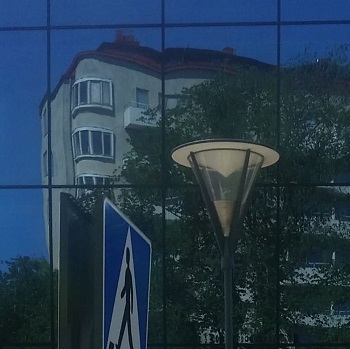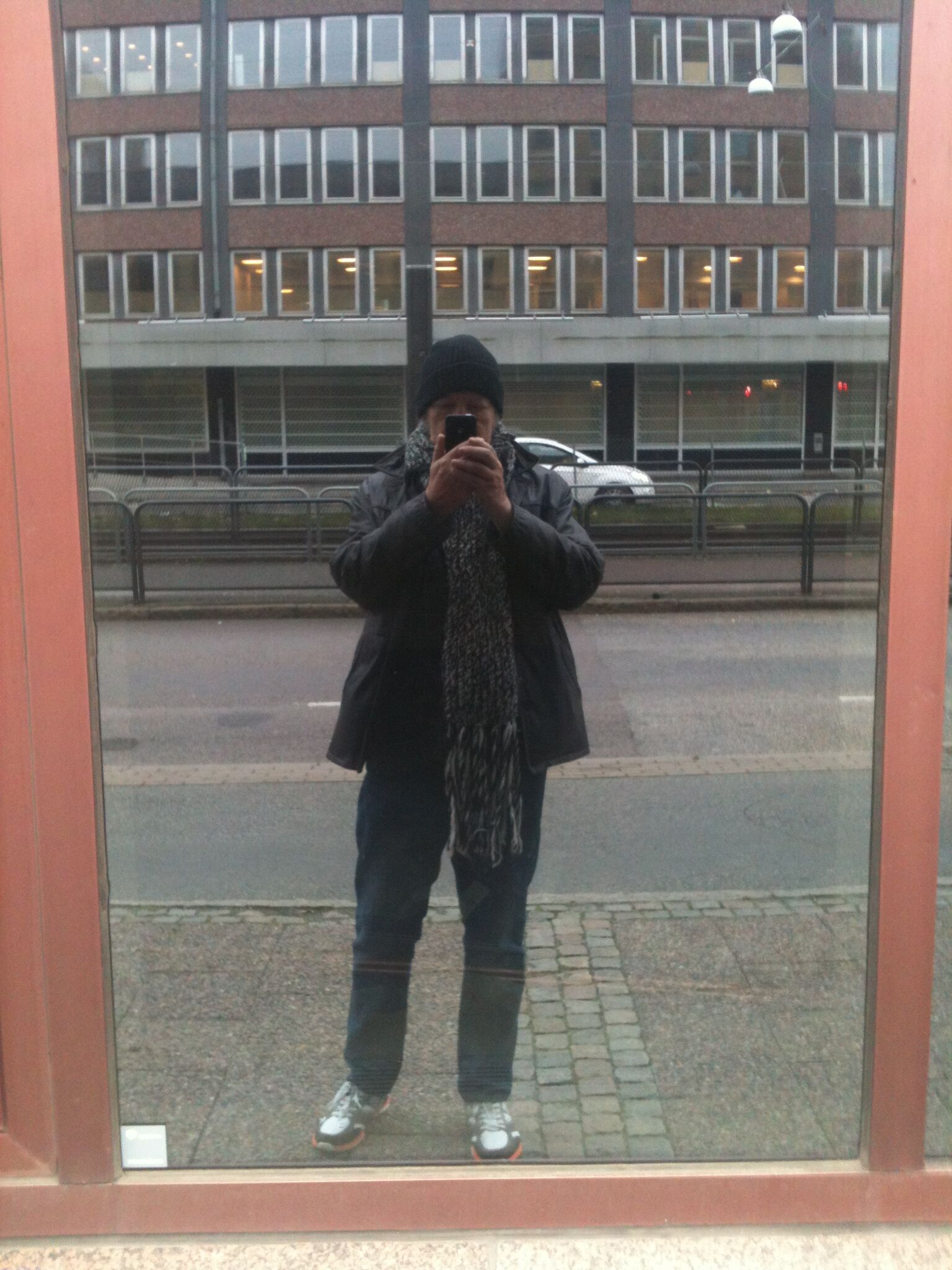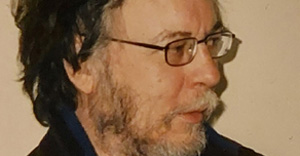
Kaj B. Genell

Gothenburg, SWEDEN

Free Palestine! ( Photo: Muhammed Ibrahim, Gaza. // Unsplash.)
I am a Swedish Author
of Facts, Philosophy and Fiction.
I was born in Sweden in 1944, and
I have no Ethnic background whatsoever.
Welcome to a Presentation of My Works!!
You´ll find links to my Books, as well as several Essays
formatted as pdf:s and as text online, all for free.
I am perhaps best known for
my
book on F. Kafka , but I have published
fourteen books, and counting.
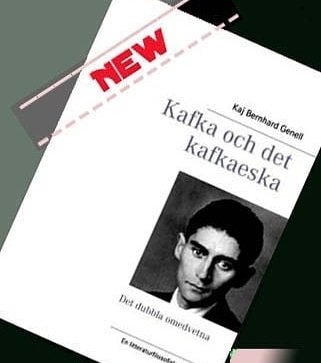
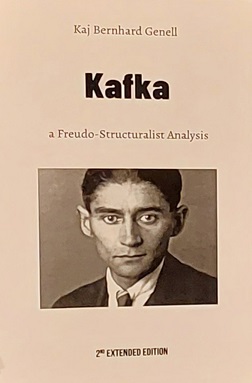
LOTS OF  online BOOKS ON THIS SITE:
online BOOKS ON THIS SITE:
 Book on Kafka (2020)
Book on Kafka (2020)
 More books and writings,
PDFs,
More books and writings,
PDFs,
audio samples, Downloads & Links
 Tegelkronaserien
Tegelkronaserien
 Kafka - och det Kafkaeska (2018)
Det " Kafkaeska " är inte bara en stilterm bland alla andra.
Kafka - och det Kafkaeska (2018)
Det " Kafkaeska " är inte bara en stilterm bland alla andra.
 Lechard Boomberg -
en halv roman. Den roman jag för närvarande arbetar på.....
Lechard Boomberg -
en halv roman. Den roman jag för närvarande arbetar på.....
 Skiss till "Freud" - myten bakom det Kafkaeska" (2025) pdf!
Skiss till "Freud" - myten bakom det Kafkaeska" (2025) pdf!
 Skiss till "Freud " - myten bakom det Kafkaeska" (2025)
Skiss till "Freud " - myten bakom det Kafkaeska" (2025)
Ongoing projekt. Widening the discussion which
is laid out in Kafka - a Freudo-Structuralist
Analysis and Kafka och det Kafkaeska.
THUS: Book on Franticek :) Kafka - Swedish version -


 FREE ONLINE VERSION!
FREE ONLINE VERSION!
THUS:
My Book on Franticek :) Kafka - English Version -


 ONLINE FREE VERSION!
ONLINE FREE VERSION!
So sad: U.S.A.
with Mafioso Donald Trump ( TACO ) as president
has become a BANANA republic!


Zionism destroys everyone it comes into contact with.
At least 52,418 people have been killed in Gaza during the ensuing war,
according to the territory's health ministry.
ICC -International Criminal Court:


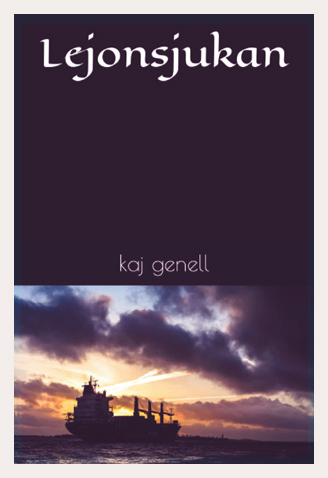
a.) KAFKA - a FREUDO-STRUCTURALIST ANALYSIS:
Kafka, Irony and Myth:

Kafka- a Freudo-Structuralist Analysis
The "Kafkaesque" is not just an ordinary concept of style.
Kafka used high-Romantic Ästhetik des Schwebens and without this half ironic reference of his to the Romantic Tradition, there would have been no Kafkaesque. The Kafkawsque - of course - is what most of all interests us, when it comes to Kafka. But what - then - is meant by the term "Kafkaesque"? We are - as our prime object of study - looking into this Concept. THUS Kafka - a Freudo-Structuralist Analysis is an analysis of Kafka's novels and short stories, with special regard to the concept of the Kafkaesque. This book concentrates on understanding what contributed to the famous Kafka effect. The author explains the structural triplicity of a discourse seen as consciousness. He also asserts how Freud, Romantic irony, and Symbolistic literature simultaneously co-work as the mythical subtext of Kafka's work.

Kafka created something that would become part of defining Modern Man. Understanding Kafka is the road to understanding Modernity. Many a Dissertation and many an Essay on Kafka have dealt with the strange "dreamlike character" or effect of Kafka´s novels and short stories. This has always been dealt with as if the "kafkaesque" was brought into the game by someone adding "Freudian symbols" to something. Nothing could be further from the truth! This is what Genell´s book Kafka - a Freudo-Structuralist Analysis (2021) shows. Rather, the case is this: Kafka's structural, literary form is based upon a refined mega-structural narrative split. It is the split between subject-"voice" and object-"voice" on the one hand, and human conscious and unconscious mind, on the other. This is not easy either to describe or to understand! The uniqueness of the works of Franz Kafka and the perplexing historical accuracy of the concept of Kafkaesque are both phenomena that many readers and scholars have noticed over the years. Through the years, a fruitful explanation of the uniqueness and accuracy of these works has been missing. Scholars have ever from the 1930ies been noticing the extraordinary qualities of Kafka text.
Strange - Kafkaesque - features have been attributed to the short stories and the novels of Kafka. The Kafka hero has - rightly - been seen as a mere figure, and the alleged dream-like landscape universe has been seen as a characteristic, and one has frequently been looking upon these entities, together with a few stylistic features, as technical dominants in the shaping of the concept of the Kafkaesque. Genell´s Kafka - a Freudo-Structuralist Analysis displays a model, together with a biographical survey and a historical perspective on possible influences, that, reversely, forms a hermeneutic, actual explanation of these features, as well as to what is denoted by the concept, from the perspective of a dynamic contextual center, explained in a model containing three levels, levels forming the discourse, typical of Kafka.
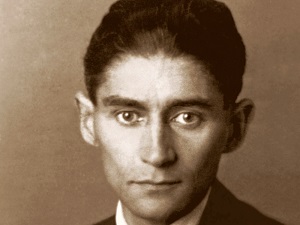
Kaj Bernhard Genell Author
- a Facts and Fiction Site
This book tries to unravel the enigma of the concept by reference to the process of creation and by Kafka´s implicit use of TWO unconscious levels within the universe of his most important works. The veil of mystery may never be lifted regarding Kafka´s eerie classics of Modernity like it will never be lifted when it comes to literature as a whole. Still, it might be essential - in order not to fall into any metaphysical trap - to know about the technique behind the Kafkaesque to be able to reflect upon the Self-Consciousness of Modern Man of the 20ieth century, a century so intensely marked by a dialogue between society and the works and ideas of Sigmund Freud. Self-consciousness of Man, as it appeared with St. Augustine, the great Italian Renaissance writers, Erasmus, Shakespeare, Montaigne, the German secular Romantics, and Hegel, swiftly developed into something even much more complex with the appearance of Freud and the groundbreaking publication of his Traumdeutung in the year of 1900, and, more so, with the creation of the Kafkaesque, with the works of Kafka, around the year of 1912. The birth of the Kafkaesque can be dated to the night in the autumn of 1912 when Kafka wrote Das Urteil.
The book, Kafka - a Freudo-Structuralist Analysis revolves solely around this strange split of consciousness and the consequences of this split. The Kafkaesque is brought about by two phenomena, and Genell is in his book discussing only the first one. 1.) A literary trick, built upon a split Unconscious ( strange as it of course may sound, and difficult -) and 2.) a unique mental sensibility. WHAT IF one had a Dream of a Dream and the two of them could communicate?? That is what happens in a Franz Kafka story! The book Kafka - a Freudo-Structuralist Analysis deals with Kafka´s novels and short stories from the aspect of the Kafkaesque, and it does so by looking for the means that create this effect. These means turn out to be largely technical. Thus, this book, Kafka - a Freudo-Structuralist Analysis, shows how Kafka uses a narratological split, split consciousness, and SPLIT Unconscious of the hero to create the Kafkaesque by a rare trick. This new book shows how Kafka became one of the most prominent artists to create and define Modernity. Kafka took part in the thrilling creation of Self-conscience of the 20ieth century, marked by a constant dialogue with Freud and his works. Self-Conscience as Man knew it since St. Augustine, the Italian renaissance writers Erasmus, Shakespeare, and Montaigne, and later with the secular Romantics and Hegel swiftly developed within Modernism into something much more complex, primarily with the appearance of Freud's "Traumdeutung" in the year of 1900. And Kafka - rebutting Schnitzler - then set out to complete it all.
The works of Kafka appeared as a reaction to: 1.) Modern times, to 2.) his own personal alienation, and to 3.) Freud. Kafka's answer to Modernity - to the modern condition - was astonishingly complex, but it turned out to be very accurate and accomplished right from the beginning. When other reactions to the Modern Condition, like Hugo Ball, Appolinaire, and Dada, displayed a picture of a chaotic and rebellious attitude to reason and morals, Kafka, much like Rimbaud actually, showed a far more complex ability to make modern society's human-understandable itself, in a universal narrative. Kafka, in exploring the Unconscious, as by Freud, and in doing so using a Romantic "AEsthetik des Schwebens," is the unique discoverer of the marvels of mind, and is, in this, equal to Freud.
Kafka - a Freudo-Structuralist Analysis sets out to explain how the Kafkaesque itself generates - even today, 100 years after its birth - an interrogation that scrutinizes the Freudian theory and our conception of the unique human consciousness. Kafka´s relation to Freud was somewhat like a son's relation to the father. Hence, Kafka did not acknowledge Freud's discoveries, methods, and notions as truths. But he saw them - ironically enough - as facts. And in a sense, they were. Freud's views were historical facts in their profound influence on the Mind and Society of the century. Kafka used Freud as part of the revealing of Modern Myth, and the myths used by Modernity. Kafka used Freud, but Kafka added on top of Freud´s model of the human psyche another split to human consciousness in his literary universe. Kafka thus did not "believe in" Freud, but he was fascinated by him. Freud suited Kafka well. Almost too well. He did not look to Freud to a great extent, ... did not own several books by Freud, but he had - like many others during those years - acquired a sort of immediate understanding of Freud's ideas through a kind of everyday osmosis. Kafka actually started as a writer of lyrical prose, short prose poems in the style of Goethe, Kleist, and Flaubert. But his dream was to write a novel, and it ought to be like the one Flaubert in his usual rage once claimed he wanted to write: a lovely book about nothing at all. So it happened that Kafka - not at all being highly intellectual or an eloquent philosopher - developed a technique for writing novels where he was extending a sole situation into a perfectly static ( i.e., nothingy ) drama displaying a struggle between conscious and unconscious. It also seems as he tried to develop the style of Tieck and the Romantics. Using his extraordinary ( perhaps autistic ) sensibility, Kafka's technique miraculously was born on one evening in 1912, writing the short story "The Verdict." The following day, he even asked his fiancee Felice for its meaning. Later, in 1912 with the writing of "The Metamorphosis" and, in 1913, the unfinished "The Trial," his technique of displaying the Kafkaesque was already full-fledged. Here he - almost FORCE by his own personal and social catastrophe - introduced a pseudo plot in a kind of pseudo novel displaying a story of a split, a struggle of a conscious instance of a person, shown as a hero-figure battling this person´s OWN Unconscious. As it turned out, this battle caused a second unconscious part to appear in the universe of this fiction. ( Examples can be found in Kafka - a Freudo-Structuralist Analysis .) It seems that the hero-figure, devoid of his Unconscious, HAD TO develop such an unconscious to be able to handle his surrounding world, which was his original Unconscious. Here we thus are having a triadic structure and a strange meeting of two unconscious instances. This fictional condition primarily results in a double exposure of the unconscious and a strange transcendence of the Ego, which cannot easily be reflected upon since it has no equivalent in reality. This is NOT EASY TO UNDERSTAND!
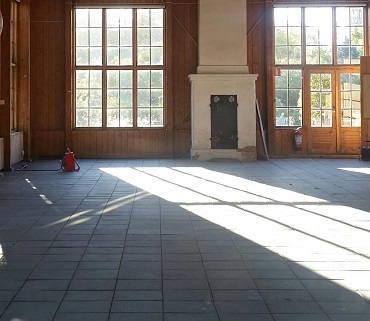
As a result of this Kafka-technique, which probably was unconscious (!) to Kafka himself, we are also - apart from the nausea of double Unconscious, a kind of self-consciousness of the Unconscious - experiencing a very intense poetry, depicting utter loneliness in a framework of a sad pseudo-protest, parallel to Weber´s, against the superpower of civil organization and law in general, as well as a hymn of the melancholy beauty of existence the like of which nobody else in the 20ieth Century has created: The concept of "Kafkaesque" has been created upon the experience of the works of Kafka by the Collective Mind, and in some yet not quite analyzed way, it also has extended our mode of perception. The concept of the Kafkaesque, and the Kafkaesque itself, AS IRONY, is vital for both the being and the understanding of our culture and being! The questions regarding this concept, raised in Kafka - a Freudo-Structuralist Analysis questions somewhat elusive, are mainly two: [ 1. ] what IS the kafkaesque? ( that is caused by this split ) And [ 2. ]: how did Kafka DO to create this, the" Kafkaesque"? These questions are highly original and deal with ideological, cultural, and psychological matters and tacit knowledge, and complicated issues concerning the ontology of fiction. Perhaps the concept of "Kafka" is an ongoing question in Modernity itself that will prevail?
THE uniqueness of the works:
THE uniqueness of the works of Franz Kafka and the perplexing historical accuracy of the concept of the Kafkaesque are both phenomena that over the years have been noticed by many readers and scholars. This book sets out to unravel the enigma of this very concept, by reference to the process of creation, and to Kafka´s implicit use of two unconscious levels within the universe of discourse of his most important works. Always a fruitful explanation of the uniqueness of these works has been missing. Scholars have ever since the 1930s been noticing the extraordinary qualities of the Kafka text. Strange - Kafkaesque - features have been attributed to the short stories and the novels of Kafka. The Kafka hero has - rightly - been seen as a mere figure, and the " dream- like " landscape-universe has been seen as characteristic, and one has frequently been looking upon these entities, together with a few stylistic features, as technical dominants in the shaping of the concept of the Kafkaesque.
This book displays a model, together with a biographical survey and a historical perspective on possible influences, that, quite reversely, forms a hermeneutic explanation to these features, as well as to what is denoted by the concept. This is achieved from the perspective of a dynamic contextual center, explained in a model containing three levels, levels steadily forming the discourse, typical of Kafka.
The veil of mystery may never be lifted when it comes to Kafka´s classics of Modernity. It might be essential to know about the technique behind the Kafkaesque to be able to reflect upon the Self-consciousness of Modern Man of the 20th century, a century so intensely marked by a dialogue between society and the works and ideas of Sigmund Freud.
Self-consciousness of Man, as it appeared with St. Augustine, the great Italian Renaissance writers, Erasmus, Shakespeare, Montaigne, the German secular Romantics and Hegel, swiftly developed into something even much more complex with the appearance of Freud and the publication of his Traumdeutung in the year of 1900, and, more so, with the creation of the Kafkaesque, with the works of Kafka, around 1912. The work of mine displays a distinct answer to the question regarding the uniqueness of Kafka and regarding the concept of the kafkaesque and how Kafka managed to achieve this very effect of the Kafkaeasque through his special technique. My work is an attempt to look for the meaning of the use of the kafkaic style. The uniqueness of the kafkaesque is noticed by many others but here it is explained by reference to the process of creation of the kafkaesque. Through the years this explanation has been missing. Kafka´s uses two unconscious levels in his major works. Sholars like W. Benjamin, Th. Adorno, M. Walser and H. Hiebel have noticed the extraordinary experienced qualities of the kafka text, the strange features owned by the hero, the hero as a mere figure and the “dream-like” universe. But I am displaying a model that can bring these features into a dynamic scheme, explained from an author´s ( albeit unconscious ) view.
It is in fact essential for Modern Man - FOR US - to be aware of this technique, to be able to reflect on the picture of Modern Man. Kafka was part of the creation of THE Self-conscience in the 20ieth century, marked by a constant dialogue with Freud and his works. Self-conscience as Man knew it since St. Augustine, the Italian renaissance writers, Erasmus, Shakespeare and Montaigne and later with the secular Romantics and Hegel, swiftly in Modrnism developed into something much more complex with the appearance of Freud and the publication of the Traumdeautung in the year of 1900. And Kafka fulfilled it all. The works of Kafka appeared as a reaction to 1.) Modern times, to 2.) his own personal alienation and to 3.) Freud. Kafka´s answer to Modernity – to the modern condition – was an astonishingly complex one, but it turned out to be very accurate and accomplished right from the very beginning. When other reactions to the modern condition, like Dada, displayed a picture of a chaotic and a rebel attitude to reason and morals, Kafka, like Rimbaud, showed a far more complex ability to encompass the soul of humans in relation to the Modern society in a universal form.
Kafka´s relation to Freud was somewhat like that of a relation of a son to the father. Thus Kafka did not acknowledge Freud´s discoveries, interpretations, methods and notions as truths. But he saw them – ironically – as facts. And in a sense they were. Freud´s views were historical facts in their deep influence on mind and society of the century. Hence Kafka used Freud as part of the Modern Myth. Kafka did not “believe in” Freud, but he was fascinated by him. He did not study Freud at great extent, but he had – like many others – acquired a sort of immediate understanding of his ideas, through a kind of everyday osmosis.
Kafka started out as a writer of lyrical prose, short prose poems. But his dream was to write a novel, and it should be a novel like the one Flaubert ( Kafka´s literary idol ) wanted to write: a very beautiful book about nothing at all. It also seems as he wanted to develop the style of Tieck and the Romantics. So it turned out that Kafka now developed a technique for writing novels where he was extending a sole situation into a perfectly static ( i.e. nothing ) drama displaying a struggle between conscious and unconscious. Using his extraordinary ( perhaps autistic ) sensibility his technique, the kafkaic, miraculously was born in 1912 with the writing of the short story of The Verdict. He asked his fiancée Felice for the meaning of it.
Later, with the writing of the unfinished The Trial, his technique of displaying the Kafkaesque was already full- fledged. Here he – almost FORCE by his own personal and social catastrophe - introduced a pseudo plot in a kind of pseudo novel displaying a story of a split, a struggle of a conscious instance of a person, shown as a hero-figure battling this person´s OWN unconscious. As it turned out, this battle originated – caused - a second unconscious part to appear in the universe of this fiction. It seems that the hero-figure, devoid of his unconscious, HAD TO develop such an unconscious to be able to handle his surrounding world, which was his original unconscious. Here we thus are having a triadic structure and a strange meeting of two unconscious instances. This fictional condition primarily results in a double exposure of the unconscious and secondly in a strange transcendence of the Ego, which cannot easily be reflected upon, since it has no equivalent in reality. As a result of this kafkaic technique, which probably was unconscious (!) to Kafka himself, we are also – apart from the nausea of double unconscious, a kind of the self-consciousness of the unconscious - experiencing a very intense poetry displaying utter loneliness and in a framwork : a sad pseudo-protest against the super power of civil organization and law in general as well as a melancholy beauty of existence. The like of which never again has been created.
b.) Writing the Fiction of Tomorrow

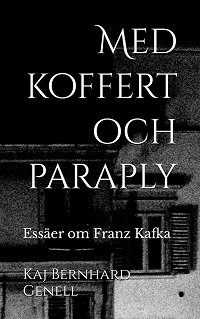
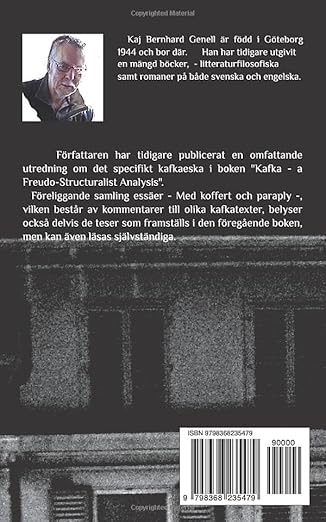
Freud - myten bakom det Kafkaeska
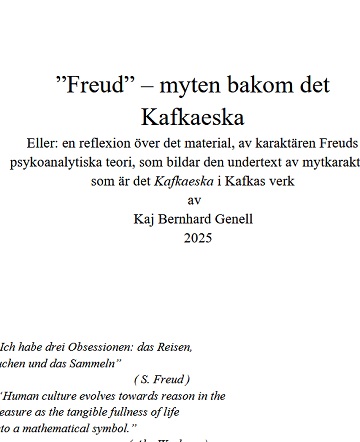
MED KOFFERT OCH PARAPLY
Med koffert och paraply
”Det gränsar ju till det
fantastiska.”, sade Karl.” ( Kafkas Amerika , s.33. )
§1. Amerika - i.e. Der Verschollene, Den försvunne - var
det första romanprojekt som Franz Kafka, en av dem
som skapade den litterära modernismen, inledde.
Eftersom romanen är känd under namnet Amerika , en
titel som sattes av nära vännen Max Brod efter Kafkas
död (1924) vid publiceringen av det av denne redigerade
manuset, så använder jag denna titel genomgående här.
Vi tar emellertid i vår granskning av detta litterära
konstverk också fasta på Kafkas arbetstitel från 1911:
Den försvunne. Vi menar att Amerika är en roman där
vi har en hjälte som försvinner in i romanen, för att där
även försvinna ur den.
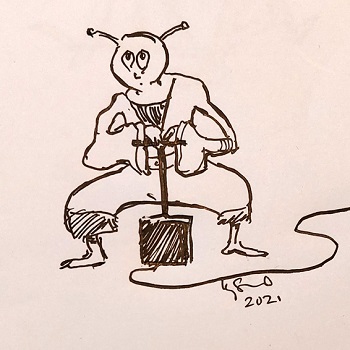
Men: Vad handlar Franz Kafkas
Amerika om, bortsett från att den handlar om ett
försvinnande, vilket i och för sig är gott nog? Handlar
romanen om myten om Amerika kanske?
Kafka avser ju med sitt Amerika troligen i viss mening
faktiskt U.S.A, ty stadsnamn som New York, Boston
och San Francisco finns med ) … men där är också
egendomliga namn, namn som tycks mer vara på
egyptiska städer…) . Vissa detaljer, typiska för USA är ju
från början lite deformerade i Kafkas tappning, bl.a.
genom den famösa inledningsdetaljen, beträffande vad
frihetsgudinnan faktiskt håller i sin högra hand. Enligt
romanen håller hon ju ett svärd i handen, och icke alls,
som den av fransmännen skänkta statyn i verkligheten,
en upplysningens fackla. Detta skenbart så obetydliga
faktum, denna alteritet, kan ju ses som emblematisk.
Många gånger kan Kafka använda sig av detta, att tidigt i
texten kasta in vad vi uppfattar som en orimlighet. Nu
kommer vi på sätt och vis in fel i varje Kafkaberättelse,
ty Kafka är ju redan helt där, från första bokstaven, i sitt
underland. Mer om det senare. Vi kommer här att möta
en fullständigt unik stilaspekt:
Vi har nämligen i Kafka en författare, som 1912 kom
upp med en ny stil och en ny teknik – som jag just ovan
påpekade – i två verk. Dessa, Domen och
Förvandlingen skapades båda i stor hast och i ren
inspiration. Med Amerika är det annorlunda. Den
påbörjades långt före, ja året före Domen och
Förvandlingen – som skrivs under hösten 1912, men
blev sedan bearbetad EFTER den storartade Domen och
Förvandlingen . Kafka arbetade alltså på sin
Amerikaroman från 1911 till minst 1913, innan han övergav den, ofullbordad.
